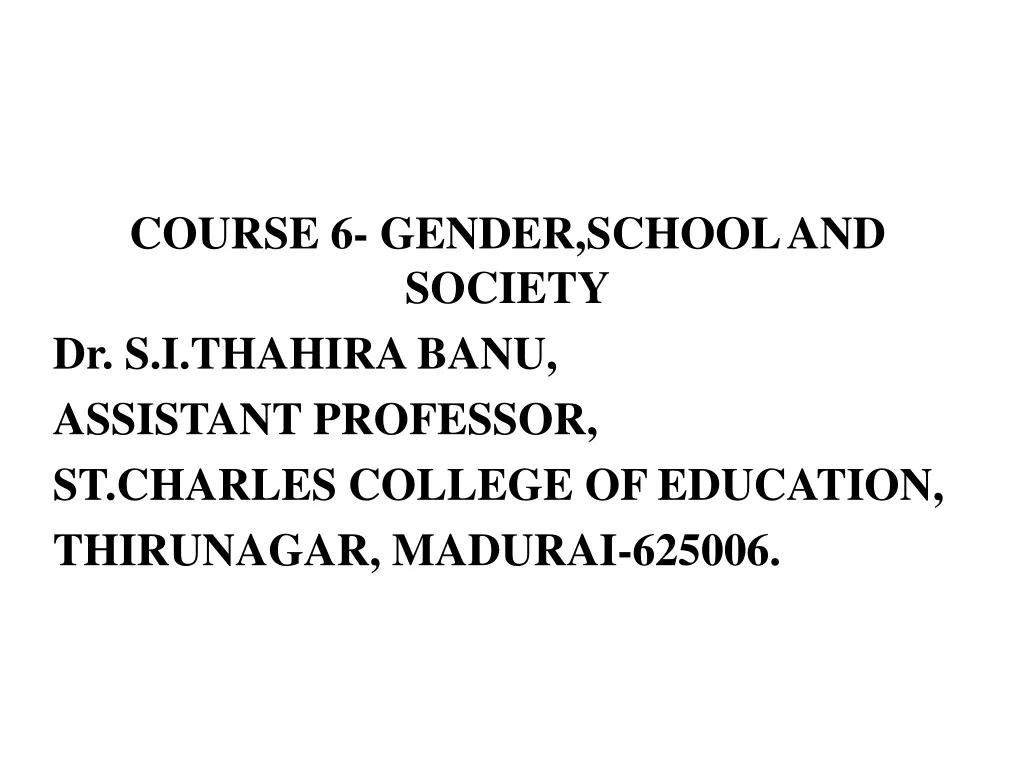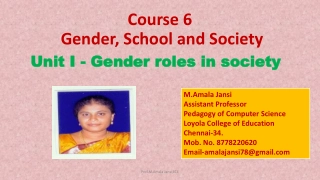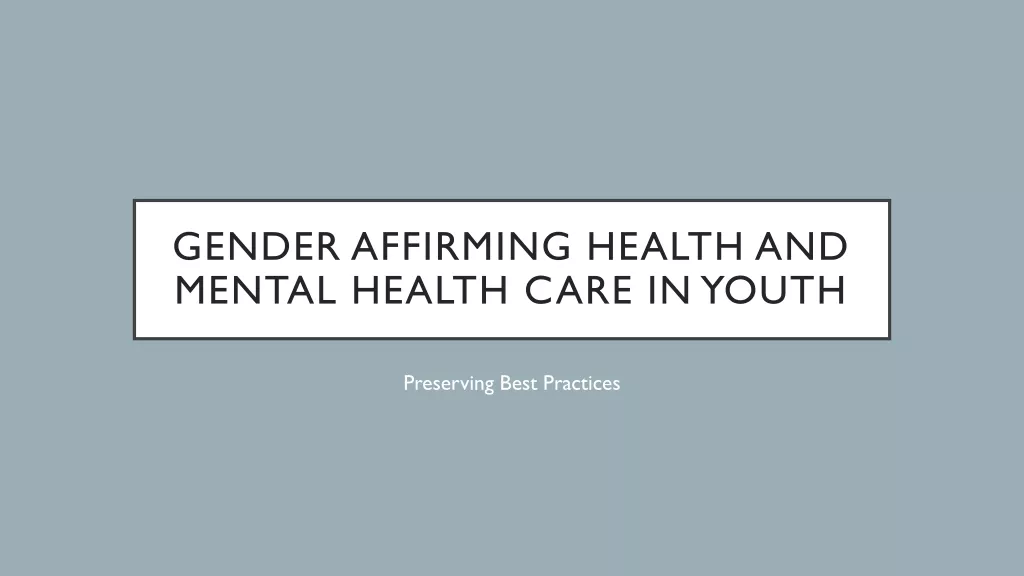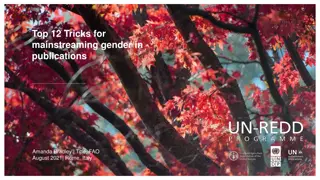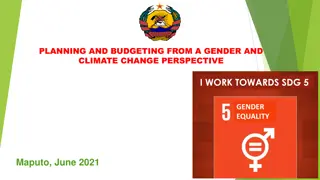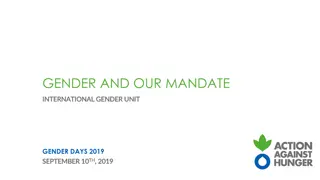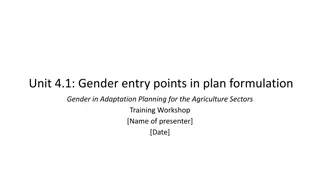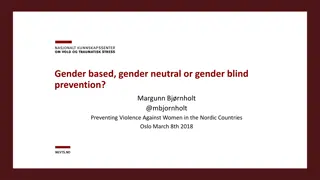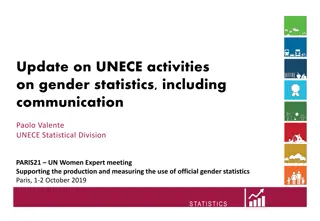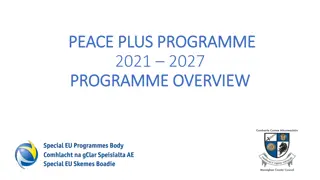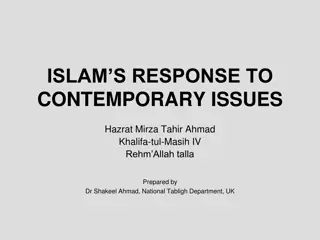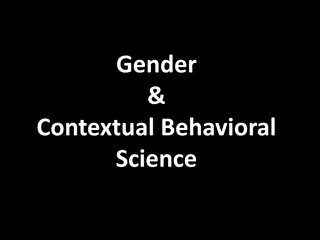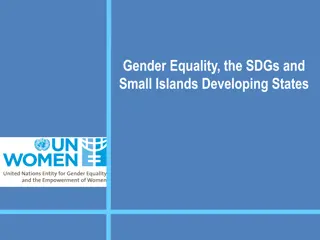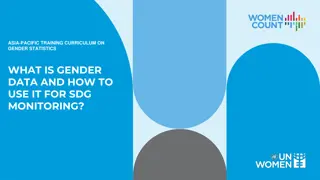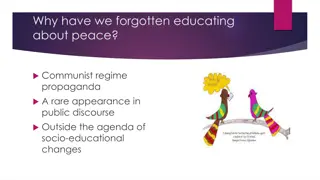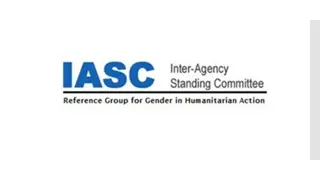Gender in Peace Education
Gender in peace education encompasses the social differences between men and women, highlighting the importance of gender equality and empowerment for sustainable peace. By integrating gender into classroom practice and developing lesson plans focusing on gender, participants can enhance their understanding and contribute to building a more equitable and peaceful society.
Download Presentation

Please find below an Image/Link to download the presentation.
The content on the website is provided AS IS for your information and personal use only. It may not be sold, licensed, or shared on other websites without obtaining consent from the author. Download presentation by click this link. If you encounter any issues during the download, it is possible that the publisher has removed the file from their server.
E N D
Presentation Transcript
Lesson Objectives At the end of this section, the participants will: Be able to define gender Be able to discuss the importance of gender in peace education Understand different ways to integrate gender into classroom practice Develop specific lesson plans that focus on gender
Guiding Questions Before you read this section, consider the following questions: What does gender mean to you? How do gender roles play out in your life? In your culture, are there assigned gender roles for men and women? If so, what are they? Riddle: A father and son are in a car accident. The father dies on impact, and the son is rushed to the hospital. In the operating room, the surgeon looks at the boy and says, I can't operate on him. He's my son. How can this be true?
Introduction Gender can be defined as the social differences and relations between men and women which are learned, vary widely among societies and cultures, and change over time They condition which activities, tasks and responsibilities are perceived as male and female Gender roles are affected by age, class, race, ethnicity and religion, and by the geographical, economic and political environment (International Labor Office, 2000).
introduction The concept of gender must be differentiated from that of sex: sex is a purely biological description, while gender connotes socially constructed categories. Gender is an important consideration in the context of peace education for a number of reasons. The most fundamental of these reasons is that women s empowerment and equality in all spheres is absolutely necessary in order to achieve a sustainable peace.
Introduction As affirmed by the UN s Beijing Declaration, local, national, regional and global peace is attainable and is inextricably linked with the advancement of women, who are a fundamental force for leadership, conflict resolution and the promotion of lasting peace at all levels (United Nations, 1995). The implications of gender on peace education are many and diverse. First, society must recognize the potential of women as peace-builders, and actively promote their inclusion in peace-making processes.
introduction Second, violence against women, which is one of the most common forms of violence worldwide, must be eliminated, with awareness education about the issue as the first step towards this goal. . Finally, societal consciousness of gender inequalities and discrimination against women in all spheres must be raised so that these issues can be recognized and addressed.
Women as Peacebuilders History has demonstrated that women, in both an individual and group capacity, are extremely effective as peace-builders. This is not to say that men are not also peacemakers, nor that women are never violent, but rather that the achievements of women in this capacity are often overlooked and merit further attention. . However, the inequalities between men and women that still prevail in our societies limit the impact of women in creating a culture of peace to much less than their true potential.
Women as peacebuilders Even though women frequently build the backbone of peace organizations, they are seldom given credit for their work. They are mostly made invisible in history books which frequently are his - story books, describing the development of violent conflicts or wars started by men. Conflicts which are solved non-violently or the work for peace, especially the work of women for peace, do not find their way into history books. This naturally has consequences for peace education
Women as peacebuilders The capacity of women as peacemakers must be recognized and promoted in governments, in nonprofit organizations, and in international relations, as well as in the classroom. The UN has stated its support for the active engagement of women in the peace process in numerous official resolutions and declarations, and now it remains for the world to follow through
Women as peacebuilders . Teachers should also make sure that the role of women throughout history is not omitted. One possible exercise for students might be to research women's perspectives from a certain historical period, if these are not portrayed in their history textbook.
Violence Against Women The term violence against women refers to any act of gender-based violence that results in, or is likely to result in, physical, sexual or continuing worldwide psychological harm of suffering to women The prevalence of such violence remains a significant obstacle to building a lasting peace, as women living in fear of gender-based violence cannot achieve true equality.
Violence Against Women Not only is violence against women an unacceptable act in itself, but according to the UN (1994), it is also a manifestation of historically unequal power relations between men and women, which have led to domination over and discrimination against women by men and to the prevention of the full advancement of women, and violence against women is one of the crucial social mechanisms by which women are forced into a subordinate position compared with men . According to Brock-Utne (2009), the unequal power (p. 206). Gender-based violence is the most brutal and overt form of the inequality that is present in all spheres of society.
Violence Against Women Thus, a crucial part of peace education must be the dissemination of information about the widespread occurrence of such violence and its negative impacts on women and on progress toward creating a culture of peace An important consideration when thinking about violence against women is the effect of the media on social perceptions of women and acceptable behavior towards women The media as a whole tend to perpetuate negative stereotypes of women, and an important step in gender- informed peace education is to recognize this trend and develop awareness about it
Violence Against Women Kempadoo, Maxwell, and Smith (2001) describe this media bias as follows: incidences of violence against women. There is a link between media images of women and primarily responsible for the home and family. Women are beaten and raped in movies, popular songs emphasize women s bodies as objects to be used and abused. [ ] Negative media images are harmful in a society where violence against women is increasing The danger is that violence against women is becoming accepted as the norm
Violence Against Women In the classroom, there are many ways in which a teacher can work to further this goal. For instance, the teacher should choose pieces of literature, film, and media carefully and in consideration of how these sources might portray women in a negative way . If use of a biased source proves necessary, this provides a wonderful opportunity for a lesson on gender stereotypes and violence and to raise students awareness of their own, often unconscious, behaviors that enable the status quo to continue.
Violence Against Women . Another way in which the teacher can help eliminate violence against women is to ensure that his/her own classroom is free of violence unwanted gender stereotypes should also not be tolerated. This rule should apply to interactions Aside from the obvious ban on physical violence, disparaging remarks and comments that enforce between all students, but especially between boys and girls.
Gender Inequalities and Socialization In world society today significant inequalities between men and women persist, ranging from gender-based violence and outright bias, to tradition-supported discrimination, to unconscious differences in behavior towards men versus women. Peace education can have a positive impact on eradicating these inequalities by raising awareness of the existence of discrimination in everyday life, and by inspiring action to eliminate these inequalities.
Gender Inequalities and Socialization The differences between society s treatment of men and its treatment of women are often so customary that they have become ingrained in the collective mindset as perfectly normal and correct However, if we stop and reexamine these behaviors, it becomes evident that many of the differences in society s attitudes towards men versus women are neither positive nor conducive to building a culture of peace.
Gender Inequalities and Socialization Consider something as basic as the toys girls and boys commonly play with: for girls it might be pretty dolls, while for boys it might be miniature soldiers. This divide begs the question: To what extent are girls and boys in our society being socialized equally or differently when it comes to learning how to care, empathize with others and engage in or endure violent behavior
Gender Inequalities and Socialization In striving to educate for peace, we must take these societal norms into account and actively try to counteract them. If young boys focus on the heroics of war in their youthful games, they build an easy familiarity with violence that fails to recognize the true gravity and horror that battle entails. Violent media images, electronic games, and toys only reinforce such inaccurate conceptions that emphasize war instead of peace.
Gender Inequalities and Socialization Even something as basic as a history book tends to place the focus on battles rather than resolutions. As noted earlier, it is difficult to educate for peace when textbooks are mostly about war. Thus teachers as peace-builders must make an active effort to draw students attention to achievements of peace rather than of war.
Promoting Gender Equality in the Classroom Self-reflection The first step for teachers wanting to counteract this trend of unequal socialization is to become aware of the gender stereotypes that they (perhaps unconsciously) perpetuate If teachers are conscious of their own perceptions of gender, they will be able to make an active effort not to recreate them in the classroom.
Equality in the Classroom Challenge students ideas of gender roles Similarly, in the context of any class assignment or discussion, the teacher can challenge students ideas about gender roles and inspire them to think critically about the origins of these inequalities Include women s perspectives in history Another way in which teachers can proactively support gender equality and peace is by emphasizing the role of women, since many textbooks tend to center more on men.
Equality in the Classroom Similarly, teachers can shift the focus to the peace-building processes of history rather than the typical emphasis on wars. Both women and peace are often underrepresented in history textbooks. Use gender-neutral language Teachers should also try to use gender-neutral language For example, using police officer instead of policeman. While the teacher should use gender-neutral language as much as possible, the teacher should also teach about gender neutrality in language, and why using gender- biased language perpetuates inequalities
Gender Equitable Education Although discrimination against girls and women exists in all spheres of society, possibly the most important areas with respect to our focus on peace education is inequality in education. Data shows that enrollment rates of girls are significantly lower than those of boys in both primary and secondary school (UNGEI, 2010, p. 12-13). Girls have less than equal access to education for various reasons, including traditional gender roles, financial limitations, cultural considerations, and early marriage or pregnancy. All these obstacles must be addressed before equal enrollment can be reached.
Gender Equitable Education However, achieving gender parity (equal numbers of boys and girls) in school is just one step towards gender equality in and through education. While parity is a quantitative concept, equality is a qualitative one (Wilson, 2003, p. 3). With progress being made toward equal access to education for girls and boys, there now remains the more difficult task of creating education that is truly gender equitable. According to Oxfam (2005), The content and delivery of education [ ] can reflect and reproduce gender inequalities.
Gender Equitable Education Girls and boys learning and interaction with each other, and the teacher, are influenced by ways of teaching, the content of the curriculum, and relations within the classroom Teachers thus have a central role to play in fostering increased gender equality in society, and can do this by making sure that their classrooms are environments that teach and reinforce positive gender relations.
Gender Equitable Education The classroom can be the starting point for fostering gender equality as a step towards a comprehensive culture of peace. As mentioned in the section above with regards to history, curriculum content must reflect gender equality. A second example would be to ensure that students in a Language Arts class read an equal number of novels by men and women authors, with a mixture of male and female protagonists
Gender Equitable Education The classroom must also be an environment that enforces gender equality. There should be no difference in the type of work assigned to boys and girls, and the same standards and expectations must apply to all students. In terms of achieving gender parity in schools, teachers can act as advocates for girls to continue their education, both through encouraging their female students and through discussing the issue with the students parents, if necessary.
QUESTIONS/ EVALUATION What is gender? What is the difference between sex and gender? Why is gender inequality relevant to peace education? What are some ways that gender inequalities are perpetuated? How can you integrate gender issues into your classroom practice? Be specific.
Questions/evaluation How are girls and boys socialized differently in your culture? Is there a relationship between this socialization, peace, and violence? What role cab the classroom play in promoting gender equality? How do you ensure that your classroom is a gender- inclusive environment? What are some of the things you do or avoid doing to achieve this?







